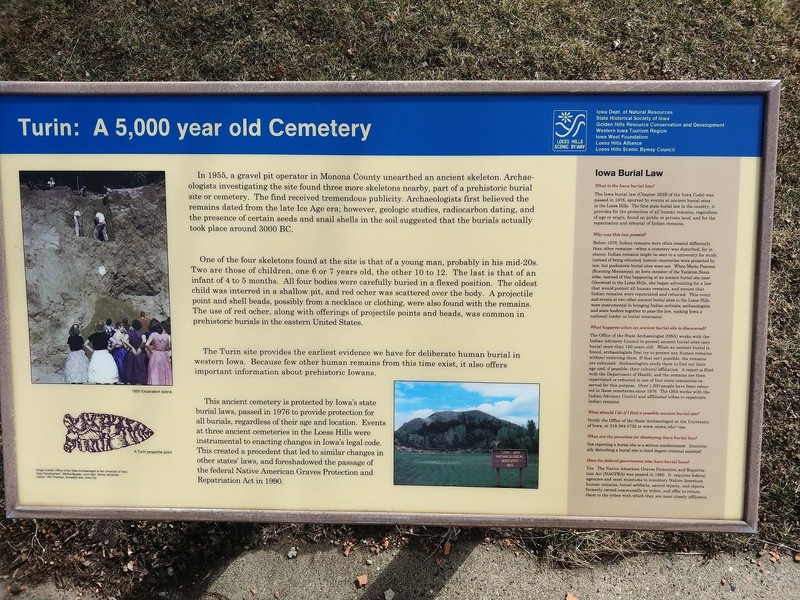Turin Man Archaeological Site
Introduction
Text-to-speech Audio
Images
Turin Man Landmark Turin, IA

Backstory and Context
Text-to-speech Audio
It should be noted here that each source I consulted had variations of how the remains were first discovered and by whom. I have compiled and presented what I consider are the most relevant details.
In 1955, a gravel pit operator (Asa Johnston) discovered human remains on his property in Turin, Iowa.[1, 2] Upon finding more human bones, Johnston alerted Monona county sheriff Don Muir and the county coroner, S. N. Anderson.[2] The bones were then taken to the coroner’s home in nearby Onawa, to be cleaned and pieced together.[2] Within a few days, experts from the University of Iowa and the Sanford Museum were consulted and taken to the discovery site.[1] The discovery attracted regional attention to a small town, and even got its moment in the spotlight as photographers from Life magazine came to document the lively excavation.[1, 3] During this time excavators found three more skeletons: an adolescent, a toddler, and an infant, totaling an incredible four complete skeletons unearthed at the site.[4]
The archaeologists and paleontologists involved were hopeful that the skeletons found at the Turin site would date back to the late Pleistocene era, better known as the “Ice Age.”[1] Pleistocene discoveries at present are rare and very difficult to find on the North American continent, much less in 1955.[1] It was clear that the remains had been intentionally buried together and that this was the site of an ancient cemetery.[1] Ancient burial grounds were also hard to come by, but experts in ancient Northern American peoples compared the Turin site to others previously found. Using the information these experts had at their disposal, they knew from the flexed positioning of all four remains and their proximity to one another that the remains had been intentionally buried together and that this was the site of an ancient cemetery.[4] In accordance with a widespread custom in the ancient world, red ocher (iron oxide) was sprinkled on the adolescent remains.[1, 4] The adolescent was also found with stone spear points and snail shell beads, which raised some doubts about the actual age of the skeletons because the spear points were made in a post-Pleistocene style.[1, 4]
Radiocarbon dating tests accompanied by further biological
and geological inquiries confirmed those doubts. These tests proved that the skeletons found
were only about 5,000-6,000 years old, during what was known as the Middle Archaic period.[1, 4] (More information about the Middle Archaic period can be found in the links section). Though not as old as scientists had originally
estimated, the discovery of four intact skeletal remains in an undisturbed
burial site provided invaluable information about North America’s ancient
peoples and their customs. The Turin Man
Archaeological Site is still one of the oldest sites of human remains ever
found in Iowa.[1, 4] This archaeological discovery along with others were key elements to passing the state's burial laws in 1976 and eventually the creation of the federal Native American Graves Protection and Repatriation Act in 1990.[4]
Cite This Entry
Dana Broer. "Turin Man Archaeological Site." Clio: Your Guide to History. May 7, 2018. Accessed April 15, 2025. https://theclio.com/entry/57845
Sources
2. “Pre-Historic Bones Found In Turin, Iowa Gravel Pit.” The Onawa Sentinel. August 11, 1955.
3. “A 15-Year Old Mystery Gets 9000 Years Older: Bones found in an Iowa sandpit may be oldest American skeleton.” Life, September 19, 1955.
4. Turin Man landmark, Turin Iowa.
5. Riehl, Nicole. “Discovering a 7,000-Year-Old Village in Des Moines.” The University of Iowa, August 19, 2011, sec. fyi. https://fyi.uiowa.edu/08/19/oldest-remains/.

